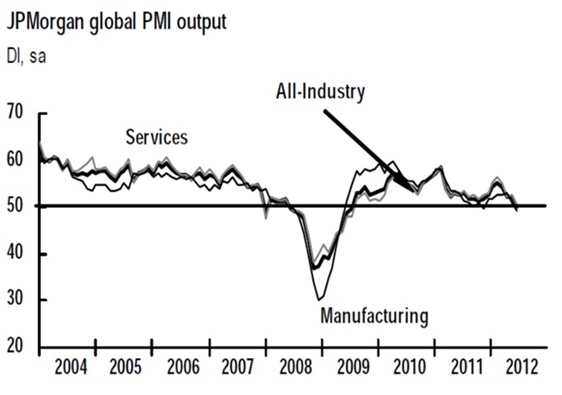John Hussman has long been on the recession bandwagon and he says his call is finally coming to fruition. In his latest note he highlights the evidence showing that we have reached the point that clearly delineates expansion from new recession (viaHussman Funds):
With regard to the economy, I noted two weeks ago that the leading evidence pointed to a further weakening in employment, with an abrupt dropoff in industrial production and new orders. Mike Shedlock reviews the litany of awful figures we’ve seen since then, focusing on the new orders component of global purchasing managers indices: U.S. manufacturing new orders and export orders plunging from expansion to contraction, Eurozone new export orders plunging (only orders from Greece fell at a faster rate than those of Germany), and an accelerating decline in new orders in both China and Japan.Recall that the NBER often looks for “a well-defined peak or trough in real sales or industrial production” to help determine the specific peak or trough date of an expansion or recession. From that standpoint, the sharp and abrupt decline we’re seeing in new orders is a short-leading precursor of output. As the chart below of global output suggests, I continue to believe that we have reached the point that delineates an expansion from a new recession.On the employment front, Friday’s disappointing report of 80,000 jobs created in June may be looked on longingly within a few months, as we continue to expect the employment figures to turn negative shortly. That said, it remains important to focus on the joint action of numerous data points, rather than choosing a single figure as an acid test. I noted last week in Enter, the Blindside Recession, GDP and employment figures are subject to substantial revision. Lakshman Achuthan at ECRI has observed the first real-time negative GDP print is often seen two quarters after a recession starts. Earlier data is often subsequently revised negative. As for the June employment figures, the internals provided by the household survey were more dismal than the headline number. The net source of job growth was the 16-19 year-old cohort (even after seasonal adjustment that corrects for normal summer hiring). Employment among workers over 20 years of age actually fell, with a 136,000 plunge in the 25-54 year-old cohort offset by gains in the number of workers over the age of 55. Among those counted as employed, 277,000 workers shifted to the classification “Part-time for economic reasons: slack work or business conditions.”
The whole note is worth a read as it also details some good thoughts on QE, but I thought I’d bring this to your attention since I’ve obviously been on the other side of this recession call for the last year.

No comments:
Post a Comment